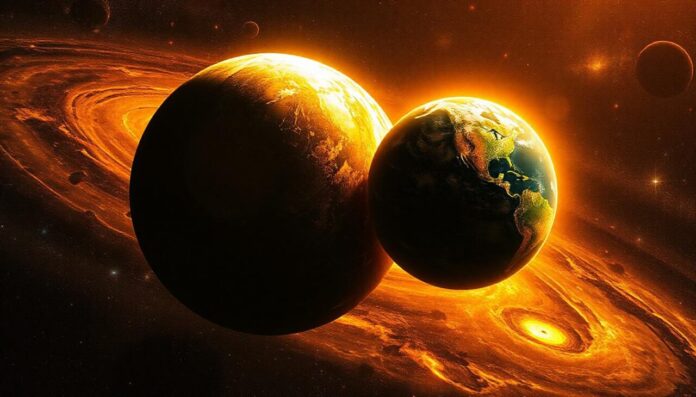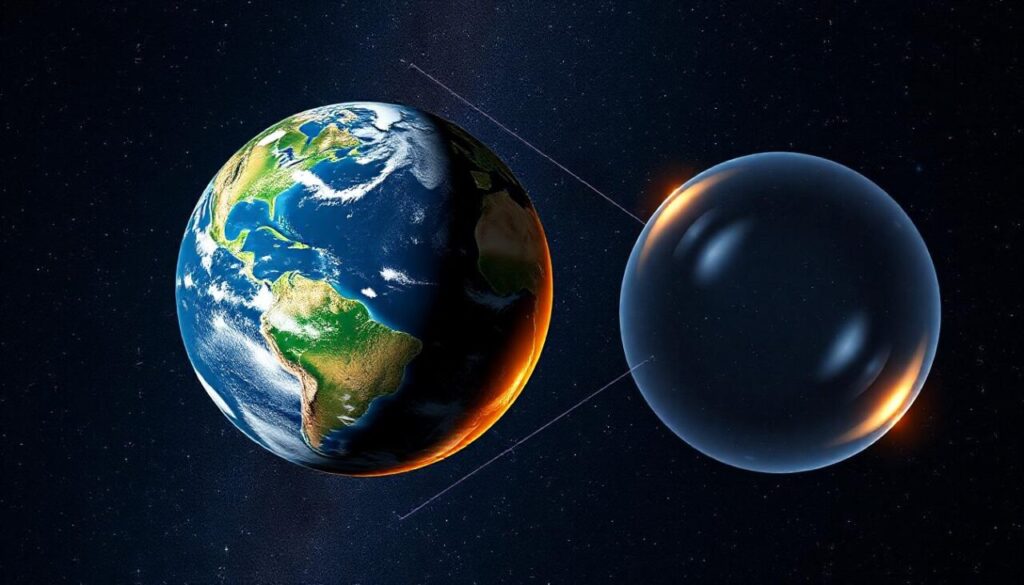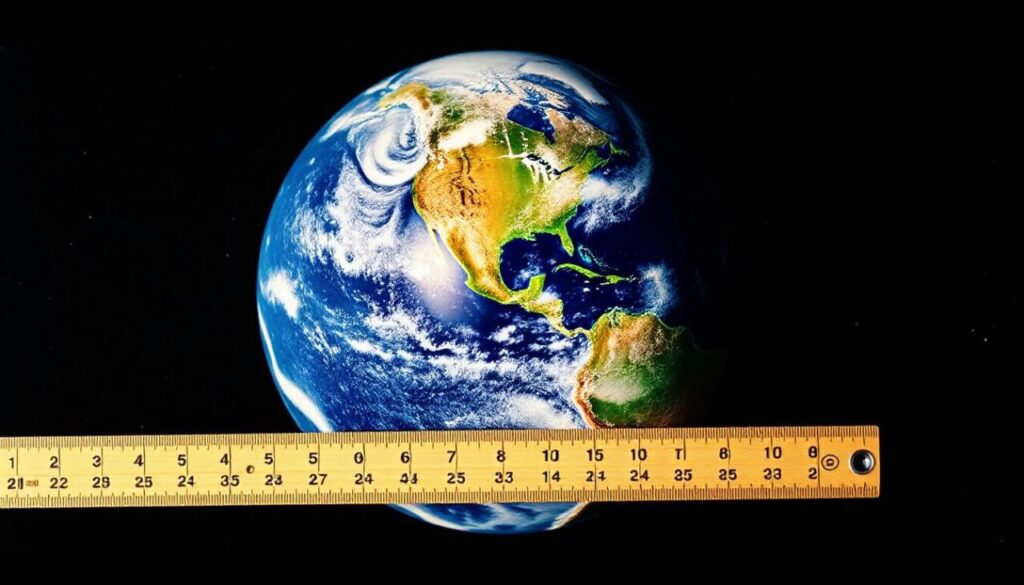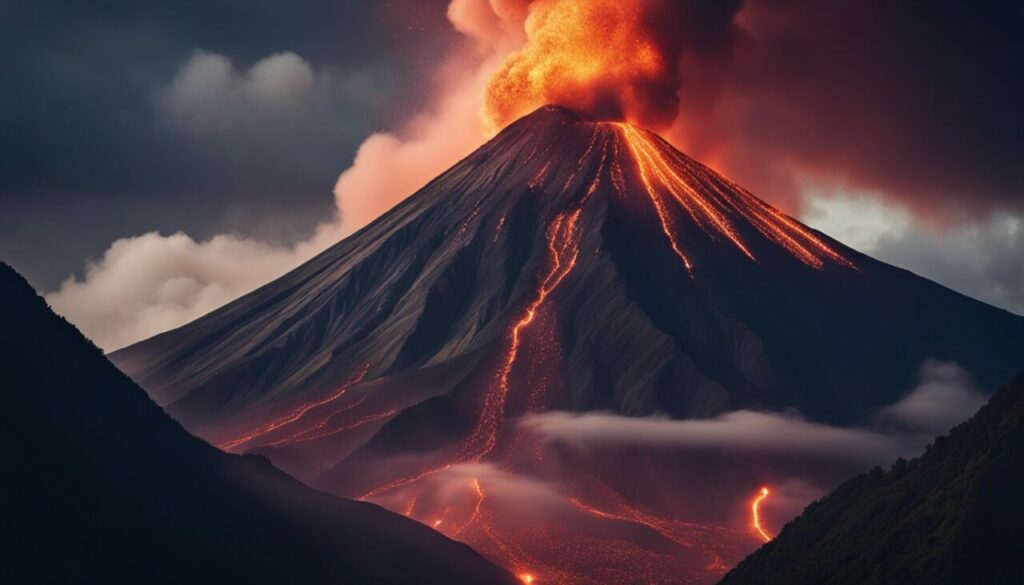
If the Earth were twice as big, our lives would dramatically change. That’s for sure!
In one way, a larger Earth might support greater biodiversity due to more land and resources, however, it could also mean stronger gravity, which would affect everything from how animals move to how plants grow.
A larger planet could also lead to bigger mountains and deeper oceans. This would change weather patterns and climate, making different places warmer or colder.
Travel would take longer, and human cultures could evolve in unexpected ways due to these changes in geography and climate.
Interestingly, a bigger Earth could, of course, also host many more people. With more space, humanity might spread out in ways that seem completely unbelievable today.
Those are just brief consequences of a larger Earth.
So, join us, as we’ll explore everything in great detail.
New Earth = Earth Size x 2 – All Consequences Summary

If Earth were twice its current size, many things on Earth would be completely different. There would be many consequences, both positive and negative.
So, let’s summarize the top 10 consequences and then we’ll dive deeper into each one.
| Rank | Consequence | Description |
| 1 | Increased Gravity | Surface gravity would double, making everything weigh twice as much, affecting human mobility and physical tasks. |
| 2 | Atmospheric Changes | Denser atmosphere with higher pressure, leading to potential climate changes and more extreme weather patterns. |
| 3 | Human Physiology | Humans might evolve to be shorter and stronger, with adaptations to handle the increased physical strain. |
| 4 | Seismic Activity | More frequent and intense earthquakes and volcanic eruptions due to greater tectonic pressure. |
| 5 | Biodiversity and Ecosystems | Evolution of sturdier species, possible limitations on flight, and changes in food chains due to higher gravity. |
| 6 | Climate and Weather Patterns | Potential for more extreme climates, stronger storms, and altered rainfall patterns due to a larger surface area. |
| 7 | Architecture and Infrastructure | Buildings and structures would need to be stronger, with potential limits on the height of skyscrapers. |
| 8 | Transportation and Space Exploration | Increased energy requirements for transportation and more challenging space launches due to higher escape velocity. |
| 9 | Natural Resources and Mining | Greater challenges in resource extraction due to deeper crust layers and higher gravity. |
| 10 | Global Water Cycle | Changes in ocean depth, stronger currents, and altered river systems affecting landscapes and human settlements. |
Size and Scale of a Hypothetical Earth

Exploring a larger Earth involves understanding its dimensions and the effects of increased gravity.
Let’s explore those.
Comparing Dimensions
Let’s do some calculations.
1. Diameter
- Current Earth Diameter: ~12,742 km (7,918 miles)
- Doubled Earth Diameter: ~25,484 km (15,836 miles)
2. Circumference (the distance all the way around the equator)
- Formula: Circumference C = π × Diameter
- Current Earth Circumference:
- Ccurrent = π × 12,742 km ≈ 40,030 km (24,880 miles)
- Doubled Earth Circumference:
- Cdoubled= π × 25,484 km ≈ 80,060 km (49,760 miles)
3. Surface Area
- Formula: Surface Area A = 4 × π × r2 where r is the radius.
- Current Earth Surface Area:
- Acurrent = 4 × π × (12,742 km / 2)2 ≈ 510 million km2 (196.9 million square miles)
- Doubled Earth Surface Area:
- Adoubled = 4 × π × (225,484 km)2 ≈ 2,040 million km2 (787.6 million square miles)
4. Mass
- Assumption: If the diameter doubles, assuming Earth retains the same density, the mass will increase by a factor of 23=8
- Current Earth Mass:
- Mcurrent≈5.97×1024kg
- Doubled Earth Mass:
- Mdoubled ≈ 8 × 5.97 × 1024kg ≈ 4.78 × 1025
Summary of comparisons

| Property | Current Earth | Doubled Earth | Comparison |
| Diameter | ~12,742 km (7,918 miles) | ~25,484 km (15,836 miles) | 2x increase |
| Circumference | ~40,030 km (24,880 miles) | ~80,060 km (49,760 miles) | 2x increase |
| Surface Area | ~510 million km² million mi²) | ~2,040 million km² (787.6 million mi²) | 4x increase |
| Mass | ~5.97×1024 kg | ~4.78× 1025kg | 8x increase |
So let’s examine most important consequences.
Gravity and Its Impacts

With a larger Earth, gravity would increase significantly.
Higher gravity would in turn affect many other things, for example:
- Human Movement: Walking and running would be much more difficult.
- Architecture: Buildings would need sturdier designs to support more weight.
- Water Bodies: Rivers and oceans could behave differently, possibly leading to stronger currents.
This change in gravity would challenge plants and animals too, as they adapt to heavier conditions.
Geological Changes

Earth’s size could greatly affect its geology. This change would impact plate tectonics and how mountains form.
It would also influence volcanic activity and earthquakes.
Plate Tectonics and Mountain Formation
If Earth were twice as big, plate tectonics would be more intense. Larger plates would move differently due to increased gravity. Shear forces might create larger faults, leading to more mountain formation.
Mountain ranges like the Himalayas could grow taller and wider. This would change habitats and climates.
New mountains might rise in different areas, affecting ecosystems.
The movement of tectonic plates would also introduce more earthquakes. Larger, more frequent events could reshape landforms, making the earth more dynamic.
Interesting fact: Earth’s largest mountain, Mauna Kea, is mostly underwater. It is over 10,000 meters tall, but only 4,207 meters rise above sea level.
Volcanism and Earthquake Activity

With a larger Earth, volcanism would likely increase. The heat inside would rise due to thicker crust and greater pressure. More magma would lead to more volcanic eruptions.
These eruptions would be more powerful and frequent, impacting air quality and climate. Ash clouds could spread further, affecting surrounding regions.
Earthquakes would also become more severe. A larger size means greater stress on fault lines. Areas that are stable now might experience unexpected seismic activity.
Interesting fact: The Ring of Fire, a chain of volcanoes and earthquakes, is home to about 75% of the world’s active and dormant volcanoes.
Atmospheric Changes

If Earth were twice its current size, its atmosphere would experience significant changes in composition and climate. This transformation would affect life, weather, and overall environmental conditions.
Atmospheric Composition
The size increase would lead to a denser atmosphere. A larger Earth would have a stronger gravitational pull, allowing it to hold more gases. This change could raise the levels of carbon dioxide and oxygen, potentially affecting life forms.
Nitrogen may still be the most abundant gas, making up about 78% of the atmosphere.
Oxygen could increase to around 25%, supporting larger organisms. High oxygen levels might lead to increased insect size, similar to ancient times.
Interesting fact: The Earth’s atmosphere has changed over millions of years, largely due to biological processes.
Weather Patterns and Climate

A denser atmosphere would influence weather patterns. With more gases, it could lead to more intense storms. Rainfall might become heavier, which could alter landscapes and ecosystems.
A larger surface area would mean varied climates across regions. This may result in larger deserts, more rainforests, and shifting seasons.
Different areas could become more prone to extreme weather events, affecting how ecosystems thrive and interact.
Effects on Life

Changes in the size of Earth would greatly influence life. A larger planet would mean shifts in ecosystems, the way species develop, and the overall health of nature.
Here are some important effects to consider.
Evolution of Species

If Earth were twice as big, gravity would be stronger. This could lead to different physical traits in many species. F
or example, animals might grow larger to support their weight. Plants might also adapt by becoming sturdier.
In addition, food chains could change. Larger animals would need more food, possibly leading to increased competition for resources.
Fish in oceans could develop differently, as bigger bodies of water would offer unique challenges and opportunities.
These changes could take many years, but they would significantly alter how species survive and thrive.
Impact To Humans

The size of Earth affects many aspects of human life. This includes where people can live and how they grow food.
So let’s look at the top 10 impacts that a doubling of Earth’s size would have directly on humans:
- Increased Gravity
- Gravity would be about twice as strong, making everything feel heavier. This would affect mobility, physical health, and daily activities.
- Physical Strain and Evolution
- The human body would experience greater strain, leading to potential evolution toward shorter, more robust physiques to cope with the increased gravity.
- Health Issues
- Higher gravity could increase the risk of cardiovascular, musculoskeletal, and respiratory problems due to the additional strain on the body.
- Altered Breathing
- A thicker atmosphere could result in higher atmospheric pressure, making breathing more difficult and possibly affecting oxygen absorption.
- Changes in Infrastructure
- Buildings, vehicles, and infrastructure would need to be much stronger and more robust to withstand the increased gravitational forces.
- Transportation Challenges
- Moving around would require more energy, potentially leading to slower travel and the need for more efficient transportation methods.
- Adaptation of Daily Activities
- Simple tasks like walking, lifting, and working could become more difficult, requiring more effort and possibly leading to changes in how people live and work.
- Impact on Agriculture
- Crops and livestock might struggle to adapt to the new conditions, leading to changes in food production, with potential shifts toward more resilient species.
- Sleep and Circadian Rhythms
- If days became longer due to a slower rotation, human sleep patterns and daily routines would need to adapt, potentially affecting overall health and productivity.
- Psychological and Social Impact
- The physical challenges of living on a larger Earth could lead to increased stress, societal changes, and possibly new social structures as humans adapt to the new environment.
Orbital Changes

When considering a larger Earth, its orbit and the effects on the Moon and tides take on new dimensions.
The size and mass changes could lead to significant shifts in these areas.
Earth’s Orbit and Day Length
If Earth were twice as big, its mass would increase significantly. This change would affect its orbit around the Sun.
A larger Earth might have a stronger gravitational pull, which could alter its position in the solar system.
A larger mass can also lead to a different rotational speed. This change might result in a longer day.
A planet that spins slower means longer time between sunrises and sunsets. It could have implications for climate and weather patterns.
The increase in size could also affect how Earth interacts with other celestial bodies. Increased gravity might mean different relationships with nearby planets and asteroids.
Interesting fact: Jupiter, the largest planet in our solar system, has a day length of about 10 hours, even though it is much larger than Earth.
Impact on the Moon and Tides

Doubling Earth’s size would impact its relationship with the Moon. The stronger gravity might pull the
Moon closer, potentially leading to a reduced distance between them. This could affect the Moon’s orbit.
Tidal effects would also change. Larger Earth means greater gravitational pull on oceans. This could result in higher and more extreme tides. Coastal areas might experience flooding more often.
Furthermore, changes in the Moon’s position could lead to noticeable effects on night skies and navigation.
This would be a major shift for both people and wildlife that depend on lunar cycles for various activities.
Interesting fact: The Moon is slowly drifting away from Earth at a rate of about 3.8 centimeters (1.5 inches) per year.



























